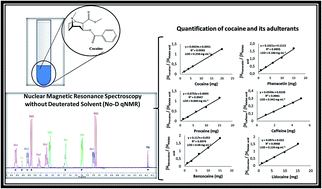Quantification of cocaine and its adulterants by nuclear magnetic resonance spectroscopy without deuterated solvents (No-D qNMR)†
Abstract
In this study, a new method was developed to quantify cocaine and some adulterants (lidocaine, caffeine, phenacetin, procaine and benzocaine) using nuclear magnetic resonance spectroscopy without the use of deuterated solvents (No-D qNMR). No-D qNMR presents as main advantages: low cost (in comparison to the use of deuterated solvents), non-destructive and rapid analysis, and being able to detect non-volatile compounds. For analytical validation achievement, figures of merit such as selectivity and specificity, linearity, quantification limit, detection limit, accuracy, precision and robustness were obtained. The built models presented excellent precision (<5%), linearity (>0.99), and LOD values which varied between 0.126 and 0.666 mg mL−1. With the purpose of verifying the predictive capacity of the models, 34 crack samples seized by the Civil Police of Espírito Santo State – Brazil were analyzed, and the average cocaine content found was around 17.5 wt%, which is in line with expectations (up to approximately 30 wt%). Moreover, 50 wt% of the samples contained phenacetin, 9 wt% caffeine, and 3 wt% procaine and lidocaine, while benzocaine wasn't identified.

- This article is part of the themed collection: Analytical Methods Recent HOT articles


 Please wait while we load your content...
Please wait while we load your content...